Department of Water Resources Mourns Death of Former Director
The Department of Water Resources is mourning the death of a former director on Saturday.
William Gianelli passed away this week at the age of 101.
The Department of Water Resources is mourning the death of a former director on Saturday.
William Gianelli passed away this week at the age of 101.
No ‘March Miracle’ for snow and rain in California, but the San Diego County Water Authority has diversified water supply sources to weather the boom-and-bust cycle of California winters.
March brought abundant precipitation throughout California, but not enough to offset a dry February. Most large urban water agencies in the state maintain a reliable water supply in wet and dry years.
“California’s climate variability is why a water resilience portfolio is needed to provide a safe and plentiful water supply,” said Goldy Herbon, Water Authority senior water resources specialist. “Whether a wet or dry year, the Water Authority and its 24 member agencies have successfully diversified water sources to ensure a reliable supply to meet the needs of the region’s 3.3 million people.”
The supply sources include water from the Claude “Bud” Lewis Carlsbad Desalination Plant, where ten workers volunteered to live on-site to keep the water flowing during the coronavirus pandemic.
March was wetter than normal for much of the region.
Some interesting numbers from last month: Palm Springs recorded their 4th wettest March on record, with more rain than San Diego!
San Diego recorded it's highest and lowest March temperature on the same day – March 3! #cawx pic.twitter.com/g0aIW7sqEv
— NWS San Diego (@NWSSanDiego) April 4, 2020
Lindbergh Field has received 9.76 inches of rain – or 108% of normal – from October 1, 2019 – April 2, 2020. Many areas in the San Diego region received snow in March, including the Anza-Borrego Desert State Park.
Even with a lackluster winter, the state’s six largest reservoirs hold between 82% and 125% of their historical averages for April 1, according to the California Department of Water Resources. Lake Shasta is 98% of its historical average and is at 79% of capacity.
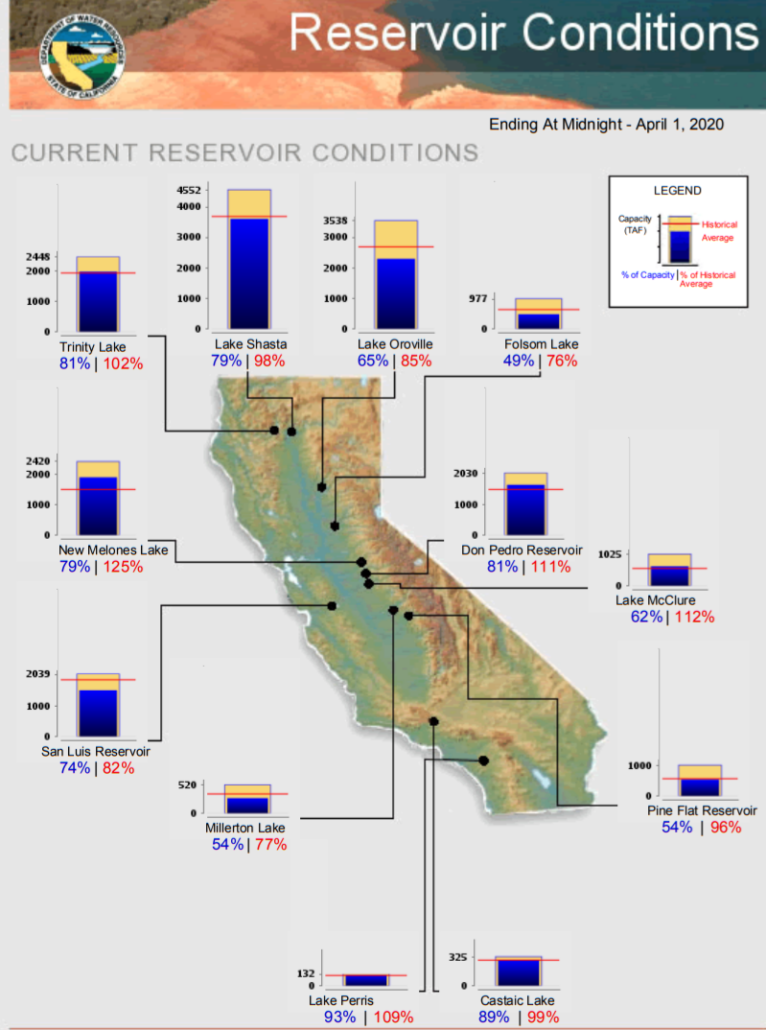
The Department of Water Resources April 1 conducted the fourth manual snow survey of 2020 at Phillips Station near Lake Tahoe. The manual survey recorded 43.5 inches of snow depth and a snow water equivalent (SWE) of 16.5 inches, which is 66% of the April average for this location.
The SWE measures the amount of water contained in the snowpack, which provides a more accurate forecast of spring runoff. Measurements from the 130 electronic snow sensors, scattered throughout the state, indicate that the statewide snowpack’s water equivalent is 15.2 inches, or 53% of the April average.
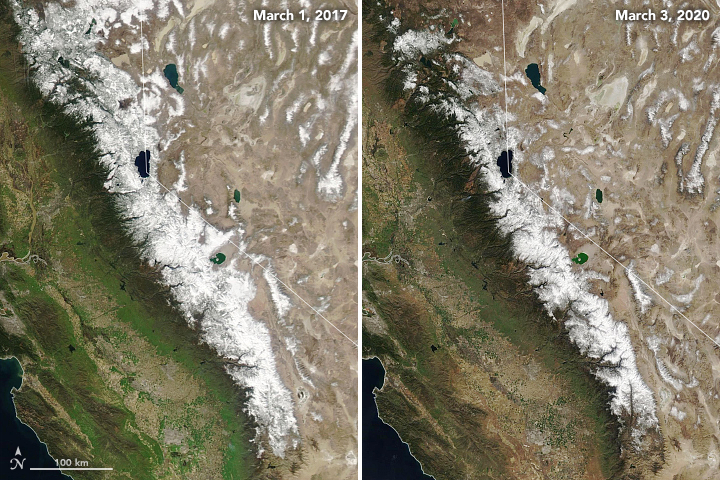
The natural-color satellite images above, acquired by the Moderate Resolution Imaging Spectroradiometer (MODIS) instruments on NASA’s Terra and Aqua satellites, show the area covered by snow in March 2020 compared to March 2017 (a record high year). Graphic: NASA/NASA JPL
“While today’s survey results show our snowpack is better off than it was just last month, they still underscore the need for widespread, wise use of our water supplies,” said DWR Director Karla Nemeth. “California’s climate continues to show extreme unpredictability, and February’s record dryness is a clear example of the extremes associated with climate change.”
On average, the snowpack supplies about 30% of California’s water needs as it melts in the spring and early summer, the state agency reported in news release.
#ICYMI DWR conducted the 4th Phillips Station snow survey of 2020. The manual survey recorded 43.5" of snow depth & a snow water equivalent of 16.5", which is 66% of avg. for this location.
Statewide, the Sierra snowpack is 53% of avg.
More here: https://t.co/LYJxIHicfC pic.twitter.com/8tRS9RrMFU
— CA – DWR (@CA_DWR) April 1, 2020
This week, the California Department of Water Resources (DWR) will install eight new measurement devices at the base of the Oroville Dam. The devices, called piezometers will monitor seepage and will be used to confirm seepage measurements that the DWR already collects. Seepage refers to a small amount of water that can pass through the dam.
DWR said seepage is normal and expected, especially in large, earthen dams like Oroville. Seepage is measured and collected through a drainage system.
There were 56 piezometers originally installed in the dam fifty years ago which, as anticipated, have since stopped functioning. DWR plans to install additional piezometers throughout the facility in the coming years.
Since 2005, the San Diego Integrated Regional Water Management Program has supported and funded water conservation, water quality and resource projects throughout San Diego County.
Program partners, including staff of the San Diego County Water Authority and its 24 member agencies, the California Department of Water Resources, and regional water industry leaders, met at the Water Conservation Garden at Cuyamaca College Monday to celebrate 15 years of achievements.
The program facilitates collaboration on water resources planning and projects in the region by water retailers, wastewater agencies, stormwater and flood managers, watershed groups, the business community, tribes, agriculture, and nonprofit stakeholders.
Projects supported and funded by the program, or IRWM, have increased long-term water supply reliability, improved water quality, created wetlands and increased local water supply sources. Funding for the IRWM projects is provided from several propositions approved by voters and administered through the California DWR.
“Since it started, the Water Authority has been a strong supporter of the IRWM, partnering with the City and County of San Diego to develop the program,” said Water Authority General Manager Sandra L. Kerl, in a keynote address at the Monday meeting. “Bringing diverse stakeholders together through collaboration funds water reliability projects throughout the San Diego region.”
The collaboration has resulted in improved water supply reliability through the successful funding of conservation, water reuse, and other supply projects throughout the region, she said.
Another benefit of collaborating through the program is it brings traditionally underrepresented communities to the table to have projects funded.
“Bringing diverse stakeholders together through collaboration funds water reliability projects throughout the San Diego region,” said Sandra L. Kerl, in keynote address today at the 2020 Integrated Regional Water Management Summit. https://t.co/vbj9KwLNdr #cawater #IRWM2020 pic.twitter.com/TZf2qOhcie
— San Diego County Water Authority (@sdcwa) March 2, 2020
The San Diego IRWM program has helped fund 25 projects in disadvantaged and underrepresented communities supporting the improvement of water reliability and water reliability in all parts of the region.
A project in Encanto to improve Chollas Creek was funded under the IRWM Program and sponsored by the Jacobs Center for Neighborhood Innovations Project.
The restoration of Chollas Creek was intended to improve environmental health and safety, surface water quality, and availability of green open space for Encanto, a disadvantaged urban community in San Diego.
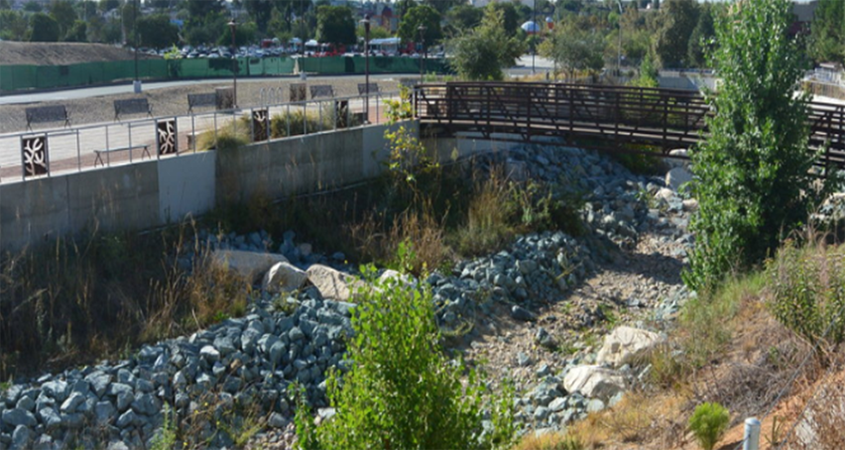
A project in Encanto to improve Chollas Creek was funded under the IRWM Program. Photo: Jacobs Center for Neighborhood Innovations Project
Wetlands, educational opportunities
Another project funded under the IRWM program, created wetlands to improve water quality at the San Diego Wild Animal Park. The biofiltration wetland project, sponsored by the San Diego Zoo Global, has also served to educate thousands of students, teachers, and park visitors through various programs.
The IRWM continues to identify opportunities to fund projects to bring multiple benefits to the region.
The program is included in California’s draft Water Resilience Portfolio, released in January. Three state agencies created the portfolio, which proposes recommended actions to help California cope with more extreme droughts and floods, rising temperatures, declining fish populations, aging infrastructure and other challenges.
Several state officials visited San Diego County on July 18, 2019 to assess the region’s water projects as part of their role in developing a water portfolio strategy for the state.
After a wet and snowy start, California’s winter has gone bust. The 2019-2020 water year started off with robust precipitation, after a series of storms in November and early December 2019.
But the new year has not been as bountiful. Dry conditions in January and February added little to the Sierra Nevada snowpack.
After a wet and snowy start, California’s winter has gone bust. The 2019-2020 water year started off with robust precipitation after a series of storms in November and early December 2019.
But the new year has not been as bountiful. Dry conditions in January and February added little to the Sierra Nevada snowpack.
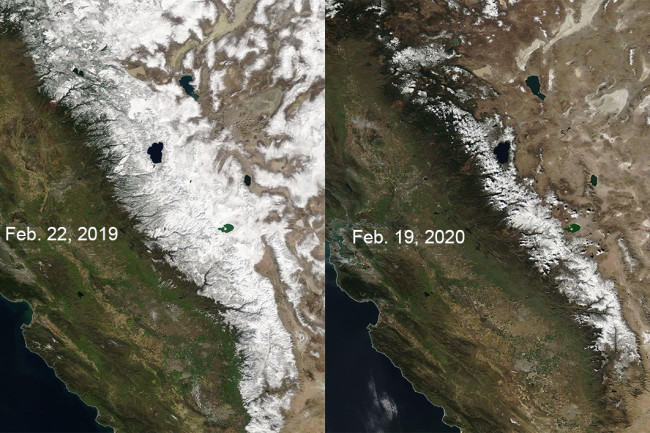
Left: 2019, Right: 2020. Sierra Nevada snowpack is below normal for this time of year, at about 58% statewide. Graphic: NASA/National Weather Service via NWS Sacramento
Due to California’s climatological variability, including periods of drought, the Water Authority and its 24 member agencies have diversified water supply sources. Those successful efforts ensure supply reliability for the region’s 3.3 million residents and its $245 billion regional economy.
“Based on current supply levels, the Water Authority and its 24 member agencies will meet anticipated demands through a combination of drought-resilient local and regional water resources,” said Goldy Herbon, Water Authority senior water resources specialist.
Herbon said the Claude “Bud” Lewis Carlsbad Desalination Plant, conserved agricultural water transfers, savings from canal lining projects and continued water-use efficiency measures are among the reasons the region’s water supply will meet demand.
The multi-decade water supply diversification plan, along with major infrastructure improvements and forward-thinking policies, also promote fiscal and environmental responsibility.
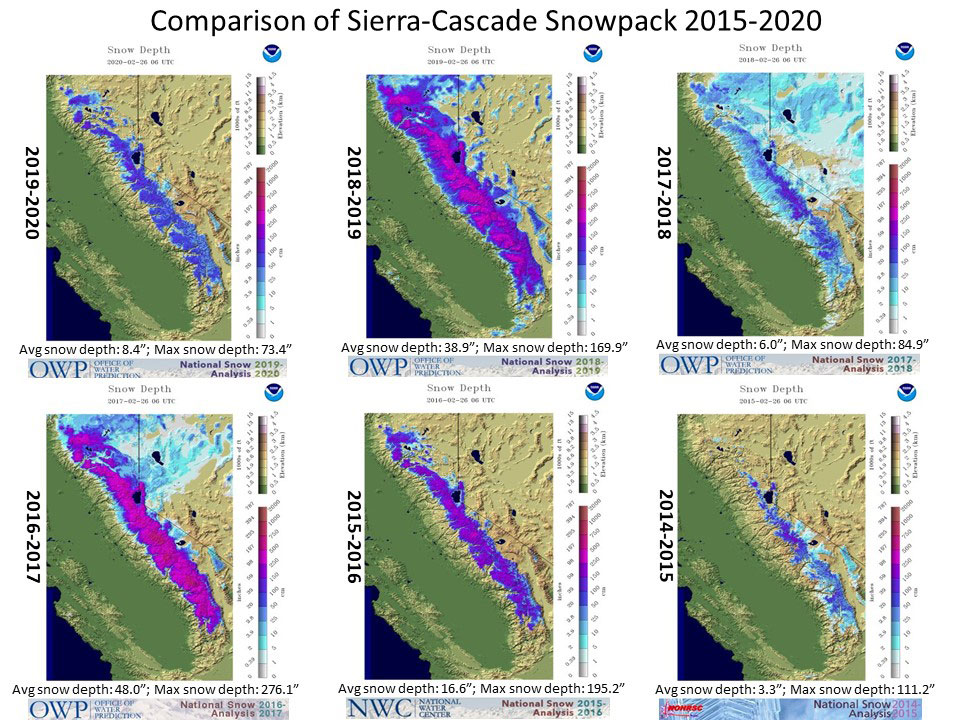
“A comparison of the snowpack across the Sierra-Cascade range over the past 6 years shows the true variability of a California wet season. While numbers are similar to the 2017-2018 winter, snow did extend into somewhat lower elevations back then.” NWS Sacramento, February 26, 2020
While rainfall totals have been closer to average in most of Northern California, downtown Sacramento and downtown San Francisco did not receive any precipitation in February, according to the National Weather Service. The last time San Francisco saw a dry February was in 1864, according to the NWS.
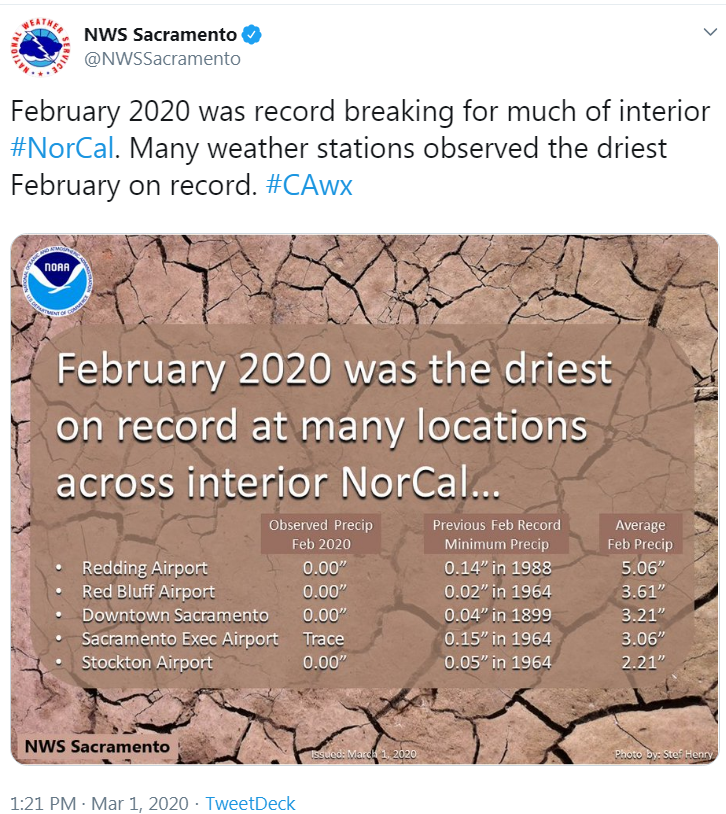
February 2020 was the driest on record for the northern Sierra (8-station index)! Observed precip was 0.2 inches compared to the average of 8.2 inches. Data courtesy of @CA_DWR #cawx #cawater pic.twitter.com/PJMD7u2Uuu
— NWS California-Nevada RFC (@NWSCNRFC) March 1, 2020
Southern California is faring better, with rainfall at 125% of the historical average at Lindbergh Field in San Diego.
Most major California reservoirs are at or above the historical averages for late-February.
The state’s largest six reservoirs currently hold between 92% (Oroville) and 132% (Melones) of their historical averages for February 26. Lake Shasta, California’s largest surface reservoir, is 107% of its historical average and sits at 78% of capacity, according to the California Department of Water Resources.
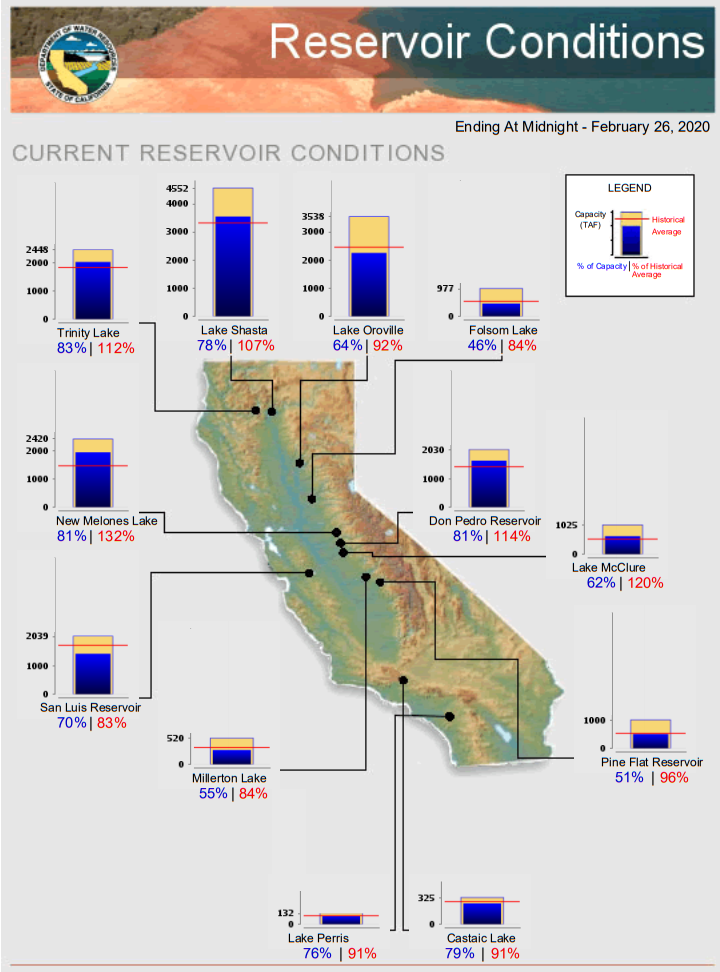
California’s largest six reservoirs hold between 92% and 132% of their historical averages for Feb. 27. Lake Shasta, California’s largest surface reservoir, is at 107% of its historical average and is at 78% of capacity. Graphic: California Department of Water Resources
The Department of Water Resources February 27 conducted the third manual snow survey of 2020 at Phillips Station. The manual survey recorded 29 inches of snow depth and a snow water equivalent of 11.5 inches, which is 47% of the March average for this location, according to a DWR news release. The snow water equivalent measures the amount of water contained in the snowpack, which provides a more accurate forecast of spring runoff.
“Right now, 2020 is on track to be a below-average year but we could still see large storms in March and April that will improve the current snowpack,” said Sean de Guzman, chief of DWR’s Snow Surveys and Water Supply Forecasting Section. “While periods of dry conditions are expected in California, climate change has made them more unpredictable and extreme which is why we must always use the water we have wisely.”

The seasonal outlook for March, April, and May sees below-normal chances for a wet period across California and the Southwest U.S. while most areas are favored to be warmer than usual. Graphic: National Weather Service Climate Prediction Center
Looking ahead, the National Weather Service Climate Prediction Center forecast favors above-normal temperatures and below-normal precipitation through May for most of California.
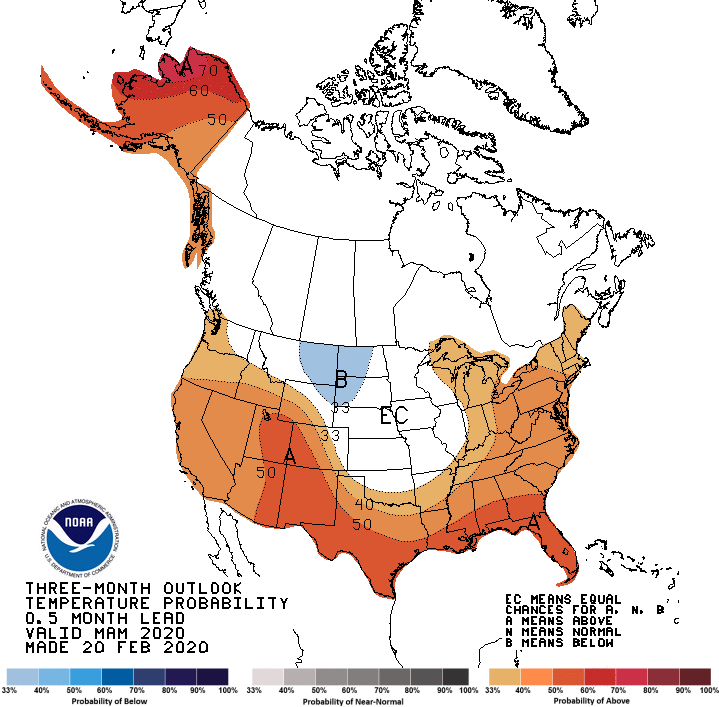
The National Weather Service Climate Prediction Center forecast favors above-normal temperatures and below normal precipitation through May for most of California. Graphic: National Weather Service Climate Prediction Center
Despite President Donald Trump’s highly publicized signing of a memo last week directing more water to San Joaquin Valley farmers, the Bureau of Reclamation’s initial allocations announced Tuesday more closely reflected the below-normal Sierra snowpack and scant winter rain.
Farmers in the Friant Division will receive 20% of their Central Valley Project contract allocation while South-of-Delta growers will get 15%, Reclamation officials said.
The state Department of Water Resources reports that as of Monday, the average snow water content in the Sierra was 41% of the April 1 average. Northern Sierra precipitation is about 51% of the seasonal average.
A state report released in December pinned blame for sinking along the California Aqueduct on excessive nearby groundwater pumping to irrigate vineyards and nut orchards.
That was a pretty pointed finger, but not pointed enough for some committee directors in the large and powerful Metropolitan Water District of Southern California.
They wanted names.
The issue came up at a meeting of MWD’s Water Planning and Stewardship Committee on Feb. 10 where a presentation was given about subsidence along the Aqueduct. Ted Craddock, acting Deputy Director of the Department of Water Resources gave the presentation and answered questions.
The California Department of Water Resources is holding a public meeting in Brentwood, Thursday, Feb. 20 at the Brentwood Community Center from 6 – 8 p.m. to review the details of the Delta Conveyance Project
The Delta Conveyance Project is the latest iteration of the state’s plans to build a tunnel through the Delta that will convey water from the Delta’s northern reaches to a forebay near Byron. From there, water will move on to the Central Valley and Southern California through the existing State Water Project network of canals. Previously known as WaterFix, or the twin-tunnels project, Gov. Gavin Newsom reduced the project to a single tunnel last year, spurring the new initiative.
Imagine more water flowing through the Delta during dry years, and a habitat restoration for endangered species. That’s what Governor Gavin Newsom is proposing in a new approach to reach agreements with water agencies—rather than issuing rules that are often challenged in court.
Carlos Romero, president of the Stockton Chapter of the California Striped Bass Association, said he used to fish in the Stockton area but the fish are becoming harder to find.
